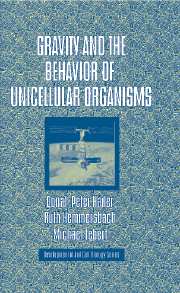Book contents
- Frontmatter
- Contents
- List of Abbreviations
- Preface
- 1 Introduction
- 2 Methods in Gravitational Biology
- 3 Image Analysis
- 4 Ciliates
- 5 Flagellates
- 6 Other Organisms
- 7 Responses to Other Stimuli
- 8 Energetics
- 9 Models for Graviperception
- 10 Evolutionary Aspects of Gravisensing: From Bacteria to Men
- 11 Perspectives
- References
- Index
8 - Energetics
Published online by Cambridge University Press: 18 August 2009
- Frontmatter
- Contents
- List of Abbreviations
- Preface
- 1 Introduction
- 2 Methods in Gravitational Biology
- 3 Image Analysis
- 4 Ciliates
- 5 Flagellates
- 6 Other Organisms
- 7 Responses to Other Stimuli
- 8 Energetics
- 9 Models for Graviperception
- 10 Evolutionary Aspects of Gravisensing: From Bacteria to Men
- 11 Perspectives
- References
- Index
Summary
In this chapter, we discuss energetic considerations regarding the mechanisms thought to underlie the orientation of single cells in the gravitational field. Although it is still under discussion, whether gravireactions are the result of a physical or physiological mechanisms or a combination of both, it is undisputed that the basis must be an interaction of gravity with a mass. This chapter compares potential mechanisms for gravidetection with physical and energetic limits set by nature. Several models consider mechanosensitive channels as an important part of gravity perception in single cells. The weak energy supplied by the gravity—mass interaction will be shown to be sufficient to at least potentially allow to activate such channels. As a model, the hearing system of the inner ear will be compared with the conditions in single cells.
Past and recent discussions were centered around the question of whether the reorientational movements in single cells are the result of a pure physical or a pure physiological mechanism or a combination of both (cf. Chapter 9). Independent of such considerations, the most basic event of the related movement reactions (gravitaxis, gravikinesis) will be an interaction between a cellular entity and gravity. This is the gravity stimulus perception. Depending on the model, we are looking at the following steps, including a receptor (typically a protein, but not necessarily a membrane protein), a receptor-signaling-state change (i.e., the point where a stimulus such as light or gravity is transformed into a chemical, biochemical, or electrical signal), and a signal transduction chain (that may or may not include an amplification).
- Type
- Chapter
- Information
- Gravity and the Behavior of Unicellular Organisms , pp. 141 - 164Publisher: Cambridge University PressPrint publication year: 2005



